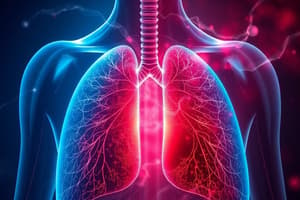Podcast
Questions and Answers
What characterizes acute hypercapnic respiratory failure (Type II)?
What characterizes acute hypercapnic respiratory failure (Type II)?
- Direct defect in oxygenation
- Normal oxygenation levels
- Inadequate alveolar ventilation (correct)
- Low carbon dioxide retention
Acute respiratory failure can be classified into three types: Type I, Type II, and Type III.
Acute respiratory failure can be classified into three types: Type I, Type II, and Type III.
False (B)
What is the arterial oxygen tension (PaO2) threshold for diagnosing hypoxemia?
What is the arterial oxygen tension (PaO2) threshold for diagnosing hypoxemia?
50 mm Hg
The principal problem in type I acute respiratory failure is the inability to achieve adequate __________.
The principal problem in type I acute respiratory failure is the inability to achieve adequate __________.
Match the type of respiratory failure to its characteristic feature:
Match the type of respiratory failure to its characteristic feature:
What is the primary goal of managing acute respiratory failure?
What is the primary goal of managing acute respiratory failure?
Endotracheal intubation and mechanical ventilation are lifesaving interventions for all patients with respiratory failure.
Endotracheal intubation and mechanical ventilation are lifesaving interventions for all patients with respiratory failure.
Name one diagnostic test that is necessary to determine the etiology of acute hypoxemic respiratory failure.
Name one diagnostic test that is necessary to determine the etiology of acute hypoxemic respiratory failure.
The analysis of ___ is essential to confirm the diagnosis of acute respiratory failure.
The analysis of ___ is essential to confirm the diagnosis of acute respiratory failure.
Match the following diagnostic tests with their purposes:
Match the following diagnostic tests with their purposes:
Flashcards
Acute Respiratory Failure (ARF)
Acute Respiratory Failure (ARF)
A sudden, life-threatening condition where the lungs struggle to exchange oxygen and carbon dioxide properly, leading to low blood oxygen and high carbon dioxide levels.
Type I ARF (Hypoxemic)
Type I ARF (Hypoxemic)
A lung problem where the body struggles to get enough oxygen into the blood; blood oxygen is low (PaO2 < 50 mmHg), but carbon dioxide isn't necessarily high (PaCO2 usually < 40).
Type II ARF (Hypercapnic)
Type II ARF (Hypercapnic)
A lung problem where the body has trouble removing carbon dioxide from the blood; carbon dioxide is high (PaCO2 > 50 mmHg), but oxygen levels may be okay (PaO2 may or may not be low).
PaO2
PaO2
Signup and view all the flashcards
PaCO2
PaCO2
Signup and view all the flashcards
ABG analysis
ABG analysis
Signup and view all the flashcards
Acute Respiratory Failure (ARF) Diagnosis
Acute Respiratory Failure (ARF) Diagnosis
Signup and view all the flashcards
Mechanical Ventilation
Mechanical Ventilation
Signup and view all the flashcards
FiO2
FiO2
Signup and view all the flashcards
Immediate ARF Treatment
Immediate ARF Treatment
Signup and view all the flashcards
Study Notes
Acute Respiratory Failure
- Defined as a drop in arterial oxygen tension (PaO2) to less than 50 mm Hg and a rise in arterial carbon dioxide tension (PaCO2) to greater than 50 mm Hg, with an arterial pH of less than 7.35.
- A major cause of morbidity and mortality in intensive care units (ICUs).
- Clinical manifestations of type I and II respiratory failure differ.
- Type I failure is a direct defect in oxygenation.
- Type II failure is a direct defect in ventilation.
Classification of Acute Respiratory Failure
- Type I (hypoxemic): Result of abnormal oxygen transport secondary to pulmonary parenchymal disease, with increased alveolar ventilation resulting in a low PaCO2.
- Type II (hypercapnic): Result of inadequate alveolar ventilation, with marked carbon dioxide elevation, and relative oxygenation preservation.
- Combined (types I & II): A combination of inadequate alveolar ventilation and abnormal gas transport.
Pathophysiology of Acute Respiratory Failure
- Type I: Hypoxemia is the hallmark, primarily due to V/Q mismatch or intrapulmonary shunting.
- Type II: Hypercapnia is the hallmark, resulting from alveolar hypoventilation, which may be caused by decreased respiratory drive, neuromuscular disorders, or chest wall pathology.
- Diffusion impairment: A rare cause of impaired oxygenation, involving thickening or destruction of the alveolar-capillary membrane.
Causes of Acute Respiratory Failure
- Intrinsic lung/airway diseases: Chronic bronchitis, acute bronchiolitis, asthma, parenchymal diseases (pneumonia, pulmonary embolism), and chest wall abnormalities (pneumothorax, obesity).
- Extra-pulmonary disorders: Neuromuscular junction disorders (muscular dystrophies, botulism), peripheral nerve problems (Guillain-Barré syndrome), spinal cord trauma, and central nervous system conditions (drug overdose, cerebral hypoxia, cerebrovascular accident, or sleep apnea).
Assessment of Acute Respiratory Failure
- Pulmonary symptoms: Dyspnea, cough, hemoptysis, wheezing, chest pain, orthopnea, paroxysmal nocturnal dyspnea, and sinus problems.
- Extrapulmonary symptoms: Night sweats, headaches, weight changes, fluid retention, nasal stuffiness, discharge, and history of smoking, childhood respiratory illnesses, family respiratory history, environmental exposures, previous respiratory problems.
Management of Acute Respiratory Failure
- Treat underlying cause: Address the root cause of the failure, such as infection, respiratory muscle weakness, or lung disease.
- Improve oxygenation and ventilation: Administer supplemental oxygen (high flow oxygen), and mechanical ventilation, possibly with assistance of pressure support.
- Weaning from ventilation: Gradually reducing or discontinuing mechanical support as the patient's condition improves.
Mechanical Ventilation
- Purpose: To maintain adequate tissue oxygenation and reduce the work of breathing.
- Types of ventilation: Positive pressure ventilation (e.g., volume-cycled, pressure-cycled, time-cycled) and negative-pressure ventilation (e.g., iron lung). Continuous Mandatory Ventilation, Assist Controlled Mode, and Synchronized Intermittent Mandatory Ventilation.
- Indications: Conditions where spontaneous breathing is inadequate or ineffective to support adequate gas exchange.
Nursing Interventions for Acute Respiratory Failure
- Focus on improving oxygenation and ventilation; monitoring and managing complications (e.g., infection, barotrauma, and hypoxemia).
- Close monitoring of vital signs, arterial blood gases (ABGs), respiratory status, and fluid balance.
- Implementing appropriate nursing interventions based on the patient's specific needs and condition.
Studying That Suits You
Use AI to generate personalized quizzes and flashcards to suit your learning preferences.





